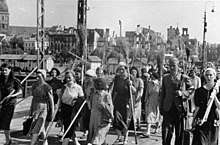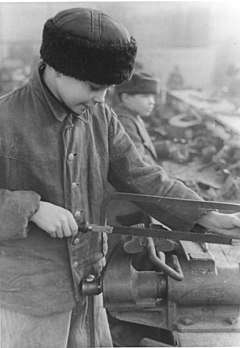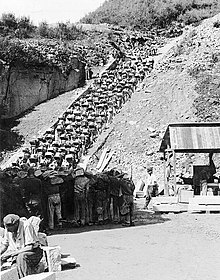Arbeitseinsatz
Arbeitseinsatz (German: for 'labour deployment') was a forced labour category of internment within Nazi Germany (German: Zwangsarbeit) during World War II. When German men were called up for military service, Nazi German authorities rounded up civilians to fill in the vacancies and to expand manufacturing operations. Some labourers came from Germany but exponentially more from roundups (łapanka) in the German-occupied territories. Arbeitseinsatz was not restricted to the industry sector and to arms producing factories; it also took place, for example, in the farming sector, community services, and even in the churches.
| Arbeitseinsatz | |
|---|---|
 Mainly female slave labour at a German rifle factory, occupied Poland. An estimated 2,500 German companies employed forced labour during World War II [1] | |
| Location | German-occupied Europe, forced labour predominantly from Nazi occupied Poland and the Soviet Union |
| Period | World War II (1939–1945) |
Labour categories
There were many affected populations who could be grouped by various (often overlapping) variables such as geographic, ethnic, religious, political, and health categories. They included German political prisoners of the SA, Gestapo, and SS; foreign civilian men and women from occupied territories of Eastern Europe (Ostarbeiter); prisoners of war; institutionalized people (mentally or physically disabled people, or medical and psychiatric patients); and various ethnic, religious, or ethnoreligious groupings (for example, Jews, Sinti, Romani, Yeniche, and Jehovah's Witnesses). They lived in various kinds of camps, called labor camps (Arbeitslager in German) and concentration camps (Konzentrationslager [KZ] in German). Nazi concentration camps were often meant not only for forced labor but also extermination. In 1945 about 7.7 million workers in the German industry were of non-German origin. Many of them were very young, and about half of them were women.[2]
Archival photographs

 Paramilitary police with workers, Riga, July 11, 1941 (Wehrmacht photo)
Paramilitary police with workers, Riga, July 11, 1941 (Wehrmacht photo) Soviet POWs clear the way for Wehrmacht column, Minsk, July 1941 (Wehrmacht photo)
Soviet POWs clear the way for Wehrmacht column, Minsk, July 1941 (Wehrmacht photo) "Jews must work", Tunis, December 1942, (Wehrmacht photo)
"Jews must work", Tunis, December 1942, (Wehrmacht photo) French mechanics at Siemens in Berlin, 1943
French mechanics at Siemens in Berlin, 1943
 14-year-old prisoner at the Wehrmacht Automotive Repair Works, Berlin, January 1945
14-year-old prisoner at the Wehrmacht Automotive Repair Works, Berlin, January 1945 Ostarbeiterin from Kiev performing domestic labor, January 1945 (SS image)
Ostarbeiterin from Kiev performing domestic labor, January 1945 (SS image) Stairs of Death in the quarry of the Mauthausen concentration camp
Stairs of Death in the quarry of the Mauthausen concentration camp
Notes
- "List of 2,500 firms that employed forced labourers". ta7.de (in German). New Germany. 16 November 1999. Archived from the original on July 19, 2011 – via Internet Archive.
- Ulrich Herbert. "The Army of Millions of the Modern Slave State". Deported, used, forgotten: Who were the forced workers of the Third Reich, and what fate awaited them. Universitaet Freiburg. Archived from the original on June 4, 2011 – via Internet Archive.
First published in the Frankfurter Allgemeine Zeitung, 16 March 1999. Extract from Ulrich Herbert, Hitler’s Foreign Workers: Enforced Foreign Labor in Germany under the Third Reich, Cambridge University Press, 1997.
External links
- Forced Laborers in the "Third Reich" by Ulrich Herbert
- Interest Group for Former Forced Labourers under the Nazi Regime
- German firms that used slave or forced labour during the Nazi era